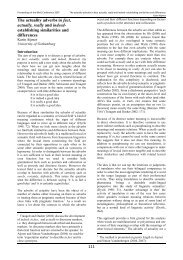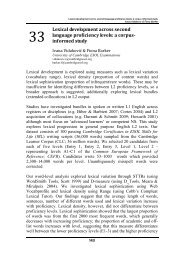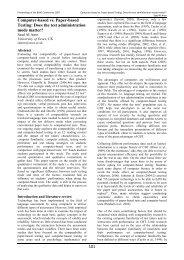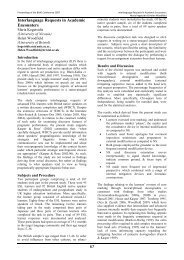Proceedings of the - British Association for Applied Linguistics
Proceedings of the - British Association for Applied Linguistics
Proceedings of the - British Association for Applied Linguistics
Create successful ePaper yourself
Turn your PDF publications into a flip-book with our unique Google optimized e-Paper software.
24<br />
Introduction<br />
Repetition by a recently arrived teacher in a complementary classroom<br />
Rika Yamashita<br />
The Development and Cross-Language<br />
Transfer <strong>of</strong> Phonological Processing Skills<br />
Among Taiwanese Young Learners <strong>of</strong><br />
English<br />
Yu-cheng Sieh<br />
Tamkang University, Taiwan<br />
ycsieh@mail.tku.edu.tw<br />
Abundant research has shown that phonological sensitivity—an ability to<br />
analyze spoken language into smaller sound units—plays an important role<br />
in learning to read alphabetic scripts among native English-speaking<br />
children (Bowey, 2001; Metsala, 1999), children <strong>of</strong> o<strong>the</strong>r alphabetic<br />
languages (de Jong, Seveke, & van Veen, 2000; Winskel & Widjaja, 2007),<br />
and children using non-Roman alphabetic scripts (Shatil & Share, 2003;<br />
Sieh, 2007).<br />
Despite <strong>the</strong> unanimous view on <strong>the</strong> crucial role <strong>of</strong> phonological sensitivity,<br />
disagreements have persisted over whe<strong>the</strong>r its development followed a<br />
stage-like or a diverse pattern (Burgess & Lonigan, 1998; Muter &<br />
Snowling, 1998; Gottardo, Stanovich, & Siegel, 1996). In addition, recent<br />
bilingual research has revealed a positive cross-language transfer <strong>of</strong><br />
phonological sensitivity in speakers <strong>of</strong> o<strong>the</strong>r alphabetic languages (Cisero<br />
& Royer, 1995; Comeau, Cormier, Grandmaison, & Lacroix, 1999).<br />
Bialystok, Luk, and Kwan (2005) fur<strong>the</strong>r proposed that such skills were<br />
transferred only when both languages were written in <strong>the</strong> same system, i.e.,<br />
alphabetic system.<br />
In stark contrast, Chinese learners <strong>of</strong> English are at a great disadvantage<br />
because Chinese has long been regarded as a language requiring no<br />
knowledge <strong>of</strong> phonological awareness. They consequently seem to develop<br />
no phonological skills in <strong>the</strong> L1, let alone transfer <strong>the</strong>m to <strong>the</strong> L2<br />
(Bialystok et al., 2005; Cheung, Chen, Lai, Wong, & Hills, 2001; de<br />
Gelder, Vroomen, & Bertelson, 1993). The deficiency in phonological<br />
awareness was attributed to a complete lack <strong>of</strong> sound cues in <strong>the</strong><br />
logographic script (Cheung, 1999).<br />
117







